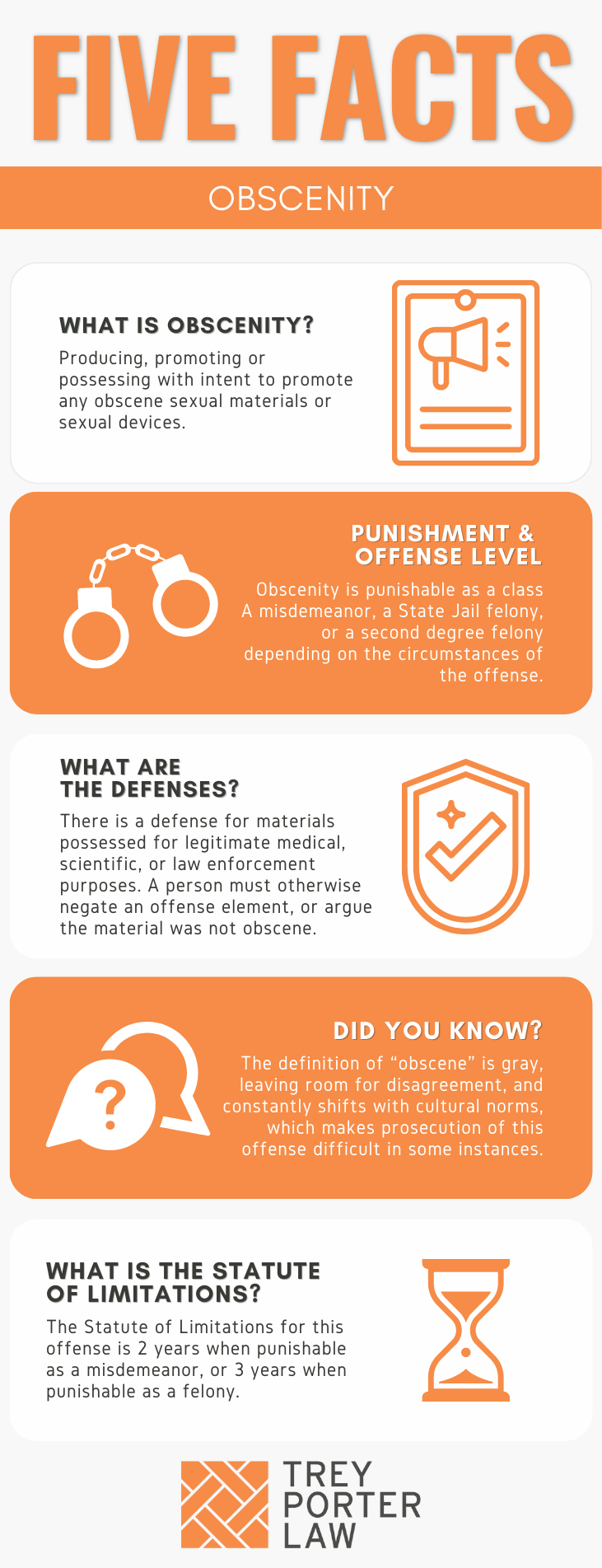WHAT IS OBSCENITY IN TEXAS?
The Texas law against obscenity prohibits promoting, producing, or possessing with intent to promote “obscene” videos, photographs, literature, and live performances. The obscenity statute also outlaws selling or distributing sex toys, or what the law refers to as “obscene devices.”

- What is considered legally “obscene”? Texas Penal Code Section 43.21 defines “obscene” as “material or a performance that:
(A) the average person, applying contemporary community standards, would find that taken as a whole appeals to the prurient interest in sex;
(B) depicts or describes:
(i) patently offensive representations or descriptions of ultimate sexual acts, normal or perverted, actual or simulated, including sexual intercourse, sodomy, and sexual bestiality; or
(ii) patently offensive representations or descriptions of masturbation, excretory functions, sadism, masochism, lewd exhibition of the genitals, the male or female genitals in a state of sexual stimulation or arousal, covered male genitals in a discernibly turgid state or a device designed and marketed as useful primarily for stimulation of the human genital organs; and
(C) taken as a whole, lacks serious literary, artistic, political, and scientific value.”
The Texas definition of “obscene” closely resembles the federal standard articulated by the United States Supreme Court in Roth v. United States.
- What is an obscene device? Tex. Penal Code Section 43.23 defines an obscene device as a device “designed or marketed as useful primarily for the stimulation of human genital organs,” which includes dildos, artificial vaginas, and other sex toys such as anal beads or penis pumps.
WHAT IS THE OBSCENITY LAW IN TEXAS?
Tex. Penal Code § 43.23. OBSCENITY.
(a) A person commits an offense if, knowing its content and character, he wholesale promotes or possesses with intent to wholesale promote any obscene material or obscene device.
(b) Except as provided by Subsection (h), an offense under Subsection (a) is a state jail felony.
(c) A person commits an offense if, knowing its content and character, he:
(1) promotes or possesses with intent to promote any obscene material or obscene device; or
(2) produces, presents, or directs an obscene performance or participates in a portion thereof that is obscene or that contributes to its obscenity.
(d) Except as provided by Subsection (h), an offense under Subsection (c) is a Class A misdemeanor.
(e) A person who promotes or wholesale promotes obscene material or an obscene device or possesses the same with intent to promote or wholesale promote it in the course of his business is presumed to do so with knowledge of its content and character.
(f) A person who possesses six or more obscene devices or identical or similar obscene articles is presumed to possess them with intent to promote the same.
(g) It is an affirmative defense to prosecution under this section that the person who possesses or promotes material or a device proscribed by this section does so for a bona fide medical, psychiatric, judicial, legislative, or law enforcement purpose.
(h) The punishment for an offense under Subsection (a) or (c) is increased to the punishment for a felony of the second degree if it is shown on the trial of the offense that obscene material that is the subject of the offense visually depicts activities described by Section 43.21(a)(1)(B) engaged in by:
(1) a child younger than 18 years of age at the time the image of the child was made;
(2) an image that to a reasonable person would be virtually indistinguishable from the image of a child younger than 18 years of age; or
(3) an image created, adapted, or modified to be the image of an identifiable child.
. . .
(j) An attorney representing the state who seeks an increase in punishment under Subsection (h)(3) is not required to prove the actual identity of an identifiable child.
WHAT IS THE PENALTY CLASS FOR OBSCENITY IN TEXAS?
The penalty category for obscenity depends on the person’s conduct, and the type of obscene material depicted. Obscenity is a:
- Class A misdemeanor, punishable by up to one year in county jail, if a person:
- promotes or possesses with intent to promote any obscene material or device; or
- produces, directs, presents, or participates in an obscene performance or any portion thereof that is obscene or contributes to its obscenity;
- State jail felony, punishable by 180 days to two years in a state jail facility, if a person:
- wholesale promotes or possesses with intent to promote obscene material or devices;
- Second degree felony, punishable by two to 20 years in prison, if:
- the obscene material depicts an identifiable child under 18 engaging in any of the patently offensive activities statutorily defined as obscene.
WHAT IS THE PUNISHMENT RANGE FOR OBSCENITY IN TEXAS?
The punishment range for obscenity charged as a Class A misdemeanor is a maximum jail sentence of one year, and up to a $4,000 fine. Obscenity charged as a state jail felony carries 180 days to two years in a state jail facility, and up to a $10,000 fine. A person charged with second degree felony obscenity faces two to 20 years in prison, and a maximum fine of $10,000.
WHAT ARE THE PENALTIES FOR OBSCENITY IN TEXAS?
A person charged with obscenity may be eligible for probation after a conviction, or deferred adjudication without a conviction. The maximum period of community supervision is two years for a Class A misdemeanor is two years, five years for a state jail felony, and ten years for a second degree felony.
WHAT ARE THE DEFENSES TO OBSCENITY IN TEXAS?
The law provides a defense to anyone in possession of obscene material for a “bona fide medical, psychiatric, judicial, legislative, or law enforcement purpose.” But the most common defense to an obscenity charge is that the material or performance is not obscene.
- What is the standard for obscenity? What constitutes obscenity is always changing, because it is based on contemporary community standards and the average person’s sensibilities. The Supreme Court has agonizingly attempted to define obscenity for nearly a century, only to conclude it cannot be defined. Justice Stewart famously wrote, “I know it when I see it.” See Jacobellis v. Ohio, 378 U.S. 184 (1964).In Varkonyi v. State, an appellate court upheld a defendant’s obscenity conviction for attaching a pornographic video to an email. The video depicted a woman being sexually penetrated by a pony. The court determined the video, which depicted sexual bestiality, appeals to the prurient interest in sex, shows sexual conduct in a patently offensive way, and lacks serious artistic or scientific value.
- Is pornography illegal under obscenity laws? Not all pornography is obscene. In United States v. Playboy Entertainment Group, the Supreme Court seemed to accept that most adult pornography, although “highly offensive,” is not obscene.The Court further held in Sable Communications of California v. F.C.C., that “[s]exual expression which is indecent but not obscene is protected by the First Amendment.”Child porn will always be illegal, but adult pornography has become central to mainstream culture. The federal government continues to pursue obscenity cases, but Texas prosecutors have all but abandoned obscenity law.
- Are stripclubs against Texas law? It is not a crime per se to own or operate a stripclub, or work as an exotic dancer. Nude and exotic dancing is expressive conduct, thus constitutionally protected under the First and Fourteenth Amendments. See City of Erie v. Pap’s A.M., 529 U.S. 277 (2000); State v. Howard, 172 S.W.3d 190 (Tex. App.—Dallas 2005, no pet.). But the government may enact zoning laws, and other content-neutral regulations.Texas law allows cities to regulate legal “sexually oriented businesses.” Sex parlors, nude studios, adult bookstores, video stores, and movie theaters, and other commercial enterprises selling, renting, or exhibiting devices or other items intended to provide sexual stimulation or gratification are allowed to operate in accordance with applicable city ordinances. See, e.g., Travis County Admin. Code § 250.041.
WHAT IS THE STATUTE OF LIMITATIONS FOR OBSCENITY IN TEXAS?
The limitation period for obscenity categorized as a Class A misdemeanor is two years. If the obscenity could be charged as a state jail or second degree felony, the limitation period is three years.
OBSCENITY IN TEXAS
Obscene material is not protected by the First Amendment. Because of the difficulty in defining obscenity, and the constant shifts in cultural standards, Texas has transitioned into a regulatory scheme for sexually oriented businesses, rather than prohibiting their operation altogether.
TEXAS OBSCENITY COURT CASES
The case law regarding obscenity in Texas shows appellate courts’ disdain for the prohibition.
- In Villarreal v. State, the Thirteenth Court of Appeals affirmed a woman’s conviction for obscenity after she sold a vibrator to an undercover officer. However, the court was clearly reluctant to enforce the law. Citing the Fifth Circuit’s holding in Reliable Consultants, Inc. v. Earle that the obscenity law with respect to sexual devices is unconstitutional, the court explained it was nevertheless bound by state law.
The current obscenity law still contains the prohibition of promoting obscene devices, but enforcement thereof has waned.
- Even as early as 1994, Texas appellate court justices openly criticized the obscenity law. In Regalado v. State, the Fourteenth Court of Appeals affirmed the defendant’s obscenity conviction for selling dildos at his adult bookstore. However, Justice Curtiss Brown wrote a two-sentence concurrence: “Here we go raising the price of dildos again. Since this appears to be the law in Texas I must concur.”
















